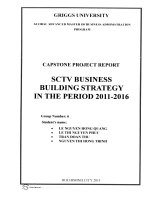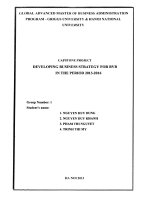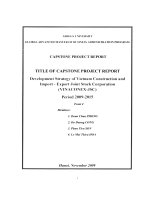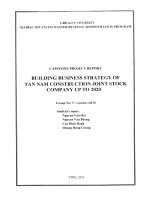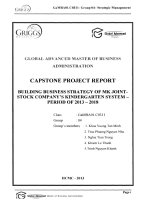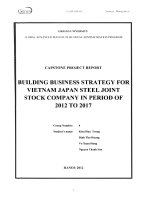Building Business Strategy of Vietnam Superintendence and Inspection Corporate in the period 2011 – 2016
Bạn đang xem bản rút gọn của tài liệu. Xem và tải ngay bản đầy đủ của tài liệu tại đây (1.26 MB, 81 trang )
GRIGGS UNIVERSITY
GLOBAL ADVANCED MASTER OF BUSINESS
ADMINISTRATION PROGRAM
CAPSTONE PROJECT REPORT
Building Business Strategy of Vietnam
Superintendence and Inspection Corporate
in the period 2011 – 2016
Group Number: 06
Student’s name: LE XUAN HOANG
NGUYEN MANH HUNG
DUONG VIET PHU
BUI VAN UOC
CLASS: GAMBA 01 X0409
HANOI 2011
Strategic Management Capstone Project Report
Group 06 – Class Gamba01 X0409
1/80
ACKNOWLEDGEMENTS
Thank you very much teachers of Global advanced master of business
administration program for teaching valuable knowledge and guide us to complete
the graduation assignment.
Thank you chairman of the board Bui Duy Chinh, deputy personnel manager Tran
Van Tuan, head of marketing department Nguyen Huong Giang, chief executives of
Vinacontrol Assessment Corporation, SGS Company, BV Company, Quatest
Company and colleagues who willingly exchange, and providing feedback
information.
With limited ability and time, the capstone project report would remain some
shortcomings, we are eager to receive remarks and contribute from you.
Strategic Management Capstone Project Report
Group 06 – Class Gamba01 X0409
2/80
TABLE OF CONTENTS
Acknowledgements
01
List of tables
05
List of draws
06
PREAMBLE
08
Chapter 1 THEORETICAL BASIS OF BUILDING STRATEGIES
12
1.1 Theory of building business strategies
12
1.1.1 Concept of business strategy
12
1.1.2 Stages of strategic management
13
1.1.3 Role of business strategy for enterprises
13
1.1.4 Classify business strategies
13
1.1.5 Define missions, purposes of business
13
1.1.5.1 Missions
14
1.1.5.2 Purposes
14
1.2 Evaluate the external environment
15
1.2.1 Analyze PEST model
15
1.2.2 Competitive model of Michael Porter
17
1.3 Analyze the internal business
19
1.4 Analyze SWOT, SPACE, BCG matrix models
20
1.4.1 SWOT matrix
20
1.4.2 SPACE matrix
22
1.4.3 BCG matrix
23
1.5 Select strategy
24
Chapter 2 ANALYZE THE REAL SITUATION OF THE VIETNAM
SUPERINTENDENCE AND INSPECTION JOINT STOCK COMPANY
(VINACONTROL)
25
2.1 Introduction to Vinacontrol
25
2.1.1 History of establishment and development
25
Strategic Management Capstone Project Report
Group 06 – Class Gamba01 X0409
3/80
2.1.2 Functions, tasks
26
2.1.3 Apparatus organization
29
2.1.4 Mission
30
2.1.5 Vision
30
2.1.6 Situation and business results
30
2.2 Analyze business environment
31
2.2.1 Economic environment
31
2.2.2 Social environment
37
2.2.3 Technological environment
39
2.2.4 Political – legal environment
40
2.2.5 Environment in business sector
41
2.2.5.1 Customers
42
2.2.5.2 Suppliers
42
2.2.6 Analyze competition among businesses which are currently
present in the market
42
2.2.6.1 Analyze competition among businesses in the same sector
43
2.2.6.2 Potential rivals
45
2.2.6.3 Substitute products
45
2.2.7 Opportunities and challenges
45
2.2.7.1 Opportunities
45
2.2.7.2 Challenges
46
2.2.8 Analyze resources of the company
46
2.2.8.1 Analyze personnel
46
2.2.8.2 Analysis of the financial situation of the Company
52
2.2.8.3 Technical material facilities
62
2.2.8.4 Analysis of the competitiveness
63
2.2.9 Strengths, weaknesses
65
2.2.9.1. Strengths
65
2.2.9.2. weaknesses
66
Strategic Management Capstone Project Report
Group 06 – Class Gamba01 X0409
4/80
2.2.10 Analyze the matrixes: SWOT, SPACE, BCG, GREAT
67
2.2.10.1 Analysis of SPACE matrix of Vinacontrol
67
2.2.10.2 Analysis of BCG matrix of Vinacontrol
68
2.2.10.3 Select the strategy by GREAT matrix
70
2.2.10.4 Analysis of SWOT matrix of Vinacontrol
71
Chapter 3 SOLUTION, SUGGESTION, CONCLUSION
72
3.1 Strategic selection
72
3.1.1 Strategic 1
72
3.1.2 Strategic 2
72
3.1.3 Strategic 3
72
3.2 Strategic targets
72
3.2.1 Continue to be the leading of the market, attack the competitors
72
3.2.2 Enterprise value has the growth of over 20%/year
72
3.2.3 Become a strong economic group
73
3.3 Functional strategies
73
3.4 Strategy of products
74
3.5 Development strategy of distribution channel
75
3.6 Management solutions of the Company
75
3.7 Competitive solution in the market
75
3.8 Solution of products and services
76
3.9 Solution of the finance
76
3.10 Solution of the personnel and apparatus organization
77
CONCLUSION
78
REFERENCE
79
Strategic Management Capstone Project Report
Group 06 – Class Gamba01 X0409
5/80
LIST OF TABLES
Tables:1.1 Great model and select strategy
24
Tables:2.1 Income statement of vinacontrol from 2006 to 2010 (financial
statements of Vinacontrol from 2006 to 2010)
30
Tables:2.2 GDP of Vietnam from 2001 to 2010 (report Vietnam’s GDP,
General statistics office from 2001 to 2010)
31
Tables:2.3 CPM competitive matrix of Vinacontrol, SGS, BV, Quatest
44
Tables 2.4 Labors, revenue, capacity (Source: The annual labors report of
Vinacontrol)
47
Tables:2.5 Training from 2005 to 2010 (annual training report of
Vinacontrol from 2005 to 2010)
48
Tables:2.6 Accounting Balance sheet of Vinacontrol 2010
53
Tables:2.7 Report of Business results of vinacontrol 2010
55
Tables:2.8 Statement of monetary circulation (source Finance report of
vinacontrol 2010)
60
Strategic Management Capstone Project Report
Group 06 – Class Gamba01 X0409
6/80
LIST OF FIGURES
Figure 1.1 Microenvironment
15
Figure 1.2 Competitive model of Michael Porter (source alan chapman 2005,
based on Michael Porter's Five Forces of Competitive Position
Model)
17
Figure 1.3 Swot Matrix
21
Figure 1.4 Space Matrix Model (source H.howe, R, mason and K.dickel
strategic management and business policy)
22
Figure 1.5 BCG Matrix Model
24
Figure 2.1 Organizational Chart of Vinacontrol (Vinacontrol company’s
charter was issued in 2008)
29
Figure 2.2 FDI from January to April (IDF report of Vietnam from January to
April of General statistics office
32
Figure 2.3 CPI from January 2010 to April 2011 (CPI report of Vietnam from
January to April in General)
32
Figure 2.4 Import and export from September 2010 to April 2011 (import-
export report of Vietnam from September 2010 to April 2011
General statistics office
34
Figure 2.5 Vietnam’s gold population structure (General office for population
family planning)
37
Figure 2.6 GDP Structure in industries (General Office for Population –
Family Planning)
38
Figure 2.7 Labor Structure in industries (General Office for Population –
Family Planning)
39
Figure 2.8 Labor qualification structure chart of Vinacontrol (Labor report of
Vinacontrol in 2010)
46
Figure 2.9 Labor contract qualification structure chart of Vinacontrol (Labor
report of Vinacontrol in 2010)
47
Figure 2.10 Training chart of Vinacontrol (Training report of Vinacontrol in
49
Strategic Management Capstone Project Report
Group 06 – Class Gamba01 X0409
7/80
2010)
Figure 2.11 Assessment of the resource of Vinacontrol Company in 2010
50
Figure 2.12 Structures of assets (source: accounting balance sheet of
vinacontrol 2010)
53
Figure 2.13 Capital structure (source: accounting balance sheet of vinacontrol
2010)
53
Figure 2.14 Revenue and post tax profit chart (source report of Business
results of vinacontrol 2010)
55
Figure 2.15 PM chart (source report of Business results of vinacontrol 2010)
56
Figure 2.16 BEP chart (source report of Business results of vinacontrol 2010)
57
Figure 2.17 ROA chart (source report of Business results of vinacontrol
2010)
58
Figure 2.18 ROE chart (source report of Business results of vinacontrol 2010)
58
Figure 2.19: SPACE matrix of Vinacontrol Company
67
Figure 2.20: BCG matrix of Vinacontrol
68
Figure 2.21: GREAT matrix of Vinacontrol
70
Figure 2.22: SWOT matrix of Vinacontrol
71
Strategic Management Capstone Project Report
Group 06 – Class Gamba01 X0409
8/80
PREAMBLE
Background, the urgency of research topic:
The country’s economy has made great achievements for over 20-year
renovation. The economy has gradually transferred to the market economy; it has
ceaselessly developed, expanded and integrated into the regional and world economy.
Businesses have operated in the field of business in new environments. Apart from
new opportunities, they are bigger difficulties, challenges than before, in both
domestic and international market. The Viet Nam Superintendence and Inspection
Joint Stock Company (Vinacontrol) is also an exception. Vinacontrol, whose
forerunner is the Superintendence and Inspection Company, is the first and largest
inspection organization with Vietnam’s top prestige. If the Company previously had a
large exclusive market and protected by the State, since 1999 up to now there are 125
companies in the field of inspection to establish, so the company must face to bigger
competition. How the business can grow uninterruptedly, have competitive strengths
and win victory in the market economy full of changes and competition is the regular
concern of most domestic businesses in economic management, in order to seek and
promote comparative advantage to maximum in a very severe environment but
including many both opportunities and challenges. In such circumstance, knowledge
of advanced strategic management, economic theories are the guideline for business
operations of all level managers in running and organizing operations of business. On
that basis, business strategy of the company plays an extremely important role in
deciding its existence and development. As employees of the company, along with
the desire of applying earned knowledge into practice and contributing a partial
strength to build the company to become a strong economic group, our group selects
the topic: “Build the business strategy of the Vietnam Superintendence and Inspection
Joint Stock Company in the period of 2011-2016” for our capstone.
Purpose, significance of research topic:
The topic aims at building the business strategy of Vinacontrol including
Product strategy, price strategy, distribution strategy and promotion strategy. Analyze
Strategic Management Capstone Project Report
Group 06 – Class Gamba01 X0409
9/80
the reality helps us recognize advantages and disadvantages of the company, then put
forth several methods in order to minimize weaknesses, take full advantage of
opportunities and promote strengths.
Scope of research:
Analyze the business environment for the company’s services from 2006 to
2010 to build the business strategy until 2016 for its products in the Vietnamese market.
Method of research:
Source of data: Primary, Secondary
Analysis techniques: PEST, SWOT, Michael Porter’s competitive model,
SPACE matrix, BCG matrix, GREAT model, functional analysis
The capstone’s structure:
PREAMBLE
CHAPTER 1: THEORETICAL BASIS OF BUILDING STRATEGIES
1.1 Theory of building business strategies
1.1.1 Concept of business strategy
1.1.2 Stages of strategic management
1.1.3 Role of business strategy for enterprises
1.1.4 Classify business strategies
1.1.5 Define missions, purposes of business
1.1.5.1 Missions
1.1.5.2 Purposes
1.2 Evaluate the external environment
1.2.1 Analyze PEST model
1.2.2 Competitive model of Michael Porter
1.3 Analyze the internal business
1.4 Analyze SWOT, SPACE, BCG matrix models
1.4.1 SWOT matrix
1.4.2 SPACE matrix
1.4.3 BCG matrix
Strategic Management Capstone Project Report
Group 06 – Class Gamba01 X0409
10/80
1.5 Select strategy
CHAPTER 2: ANALYZE THE REAL SITUATION OF THE VIETNAM
SUPERINTENDENCE AND INSPECTION JOINT STOCK COMPANY
(VINACONTROL)
2.1.1. Introduction to Vinacontrol
2.1.2. History of establishment and development
2.1.3. Functions, tasks
2.1.4. Apparatus organization
2.1.5. Mission
2.1.6. Vision
2.1.7. Situation and business results
2.2 Analyze business environment
2.2.1 Economic environment
2.2.2 Social environment
2.2.3 Technological environment
2.2.4 Political – legal environment
2.2.5 Environment in business sector
2.2.6 Analyze competition among businesses which are currently present in the
market
2.2.6.1 Opportunities and challenges
2.2.6.2 Opportunities
2.2.6.3 Challenges
2.2.7 Analyze resources of the company (Internal analysis)
2.2.7.1 Analyze personnel
2.2.7.2 Analysis of the financial situation of the Company
2.2.7.3 Technical material facilities
2.2.7.4 Analysis of the competitiveness
2.2.8 Strengths, weaknesses
2.2.9 Analyze the matrixes: SWOT, SPACE, BCG, GREAT
Strategic Management Capstone Project Report
Group 06 – Class Gamba01 X0409
11/80
CHAPTER 3: SOLUTION, SUGGESTION
3.1 Strategic selection
3.1.1 Strategic 1
3.1.2 Strategic 2
3.1.3 Strategic 3
3.2 Strategic targets
3.2.1 Continue to be the leading of the market, attack the competitors
3.2.2 Enterprise value has the growth of over 20%/year
3.2.3 Become a strong economic group
3.3 Strategies of the parts
3.4 Strategy of products
3.5 Development strategy of distribution channel
3.6 Management solutions of the Company
3.7 Competitive solution in the market
3.8 Solution of products and services
3.9 Solution of the finance
3.10 Solution of the personnel and apparatus organization
CONCLUSION
Strategic Management Capstone Project Report
Group 06 – Class Gamba01 X0409
12/80
CHAPTER 1:
THEORETICAL BASIS OF BUILDING STRATEGIES
1.1. Theory of building business strategies
1.1.1. Concept of business strategy
For existence and development, each business should define long-term
objectives and methods of operation to fulfill given objectives; in other words,
business managers should build their business a specific business strategy. There
are many definitions of strategy; in the viewpoints of each author, definitions are
more or less different.
According to Chandler, strategic management means, “define basic and
long-term objectives, purposes of a business and apply a chain of actions as well as
distribute necessary resources to implement those objectives”
Quinn put forth a concept more generally: “Strategy is an integrated pattern
or plan of main purposes, policies, and a chain of actions into a general which is
strictly united”.
Johnson and Scholes defined that “Strategy is a long-term orientation and
scope of an organization in order to obtain competitive advantage for the
organization through identifying its resources in a changeable environment, for
satisfying the market needs and expectation of concerned parties”.
Michael E. Porter said, “Strategy is an art of building competitive
advantages. Or Strategy is a chain of complex actions in order to mobilize resources
of an organization as possible, for achieving a certain objective”.
Whatever approach is, the nature of business strategy is still to outline the
future image of business in its scope of operation. Under this interpretation, the term
business strategy uses for three different meanings:
- Establish long-term objectives for business.
- Release general action plans.
- Select action methods, implement and distribute resources to carry out
objectives.
Strategic Management Capstone Project Report
Group 06 – Class Gamba01 X0409
13/80
1.1.2. Stages of strategic management
- Establish strategies: develop missions, define opportunities, challenges, strengths
and weaknesses; build long-term objectives.
- Implement strategies: Set out annual objectives, release policies, personnel
encouragement, and resources distribution of business to fulfill given objectives.
- Evaluate strategies: supervise achieved results and established operations, measure
and define achievements, and have necessary adjustments in accordance with the
real situation.
1.1.3. Role of business strategy for enterprises
As a business manager, you must have a strategy to succeed. Business
strategy looks at the distant future of the company. The company managers are easy
to forget and ignore business strategy because they are very busy with their current
works. In such case, it could not know how to define business works and where they
are. With good strategic skills, set out practical objectives and clearly know how to
achieve them in the future. As a business manager, we could not authorize others to
build business strategies.
1.1.4. Classify business strategies
Cost of leadership strategy: Includes a mass of actions in order to produce
commodities or services with lowest cost may be acceptable for customers.
Differentiation strategy: Include a mass of necessary actions in order to
produce commodities or services that customers think that those products are
different and this differentiation is important to them.
Focus strategy: Is a mass of actions in order to produce commodities or
services for serving the needs of a specific competitive market segment.
Cost-differentiation combination strategy: apply this strategy to create the
flexibility for business.
1.1.5 Define missions, purposes of business
1.1.5.1 Missions: A mission shows basic functions of an organization in the
society; the organization produces commodities and services in order to serve its
customers. A clear business mission must meet the following factors:
Strategic Management Capstone Project Report
Group 06 – Class Gamba01 X0409
14/80
- Purpose: Why has the business existed? Has it produced wealth for shareholders?
Has it existed for satisfying all needs of founders and managers (including workers
and the society in general?)
- Strategy and scope of strategy: A mission statement delivered business theory for
businesses and therefore, should define two points: Products and services provided
by the business, the business’s capacity; then the business can try its competitive
methods.
- Policies and behavior standards: A mission should be specified by daily activities. For
example, if the business mission consists of providing the best services for customers,
policies and standards must be created and supervised to inspect services supply.
- Values and culture: The business’s values are unsaid basic faiths of its employees.
These values include principles of business, loyalty and commitment, instruction of
expected behaviors, a great significance of mission helps create a working
environment covering common purposes.
- What has the role of mission statement played in making marketing plan? In fact,
a right mission statement could clarify 3 points as follows: It points out main
features of marketing plan, which should seek how to complete mission. It releases
a method for evaluating and inspecting marketing plan, whether marketing
decisions suitable to that mission or not? It creates a motivation to implement
marketing plan.
1.1.5.2 Purposes:
Purpose is a result gained in the future under given plan
Purpose conditions: must be specific, clear, measurable, workable, unified.
Purpose classification: for long-term purposes, they often are related to the
ability of earning profits, capacity, competitive position, personnel development,
personnel relationship, technical guidance, social responsibility.
Factors affecting purpose establishment:
- Internal conflict
Strategic Management Capstone Project Report
Group 06 – Class Gamba01 X0409
15/80
- Excessively emphasize on fulfilling purposes causing reaction of different groups
when purposes achieves not as expected
- Relative authority among the company’s leaders
- Qualifications of managers
- The company’s resources
- Forces of the external environment such as owner, supplier, rivals
1.2 Evaluate the external environment:
1.2.1 Analyze PEST model
The external environment
consists of all factors outside the
business beyond the control of
managers; it has a great influence on
implementing the business’s purposes.
It affects the company’s growth and
profitability. Analyze these factors
helps the business define its position
and special characteristics of the
environment and age that it’s existing,
define impacts of the external
environment on the business and then release suitable decisions for strategic
planning. The microenvironment consists of 6 main factors: political and legal,
economic, technological, socio-cultural, demographic and global factors
- Political – legal environment
The change in political and legal environment will have a big influence on
the process of implementing business strategy of business. Businesses, which invest
in a domestic area or invest transnational pay much attention to the political
environment, their influence on the Government or the Government’s influence on
them. Pay attention to the following factors: economic reform, administrative
reform, policy change related to sector, tax policies, environmental safety and
Figure 1.1 Microenvironment
(Source: provenmodels.com)
Strategic Management Capstone Project Report
Group 06 – Class Gamba01 X0409
16/80
protection, promulgation, amendment of regulations on resource use and natural
environmental protection. Effectively settling environmental problems is an
essential condition for sustainable growth.
- Economic environment
The microenvironment defines the healthiness, prosperity of the economy; it
always exerts influences on businesses and sector. The economic environment
represents the nature and orientation of the economy where the business is running.
Impacts of the economy on a company can change the ability of producing values
and revenue. Four important factors of the macroeconomics are growth rate of the
economy, interest rate, exchange rate and inflation rate.
- Technological environment
Technological changes affect many parts of the society, mainly through
products of technological process. Including operations concerning create new
technologies, apply them to make new products and materials. Change in technological
environment will bring the business both opportunity and threat. Opportunity is
improve the ability of making new products with high competitive strength; threat is
make the life cycle of products reduce. The most important impact of technological
change is affect-joining barriers and the sector’s re-structure.
- Socio-cultural environment
Social changes also create both opportunity and threat. A business wants to
exist along with time, partners, be accepted by the society; it is sure to attach much
importance to business culture. Socio-cultural values create the society’s
foundation; therefore, it often leads changes in technological, political-legal,
economic and demographic conditions.
- Demographic environment
Include problems concerning population, age structure, geographic
distribution, ethnic community and revenue distribution. The viewpoint of goods
and services consumption of the local and regional people and the consumption
viewpoint of sex, age, occupation, affect the formation of markets and business
Strategic Management Capstone Project Report
Group 06 – Class Gamba01 X0409
17/80
strategies as well. Life style also affects the needs of goods and services including
type, quality, shape, and model. The speed of population growth has a positive
effect on the contents of business and production strategy of business.
- International, global environment
The tendency of integration and globalization in the world and in Vietnam
fosters businesses to pay attention to international factors when they plan a long-
term, highly integrated strategy, which has the ability to out-reach geographical and
political sphere. Global segment includes related global markets, changing current
markets, important international political events, features of basic institution and
culture on global markets.
1.2.2 Competitive model of Michael Porter
Figure1.2 Competitive model of Michael Porter (Source Alan Chapman 2005,
based on Michael Porter's Five Forces of Competitive Position Model)
Strategic Management Capstone Project Report
Group 06 – Class Gamba01 X0409
18/80
Competitive pressure of suppliers
Quantity and scope of suppliers: Quantity of suppliers will decide their
competitive pressure, negotiation power for the sector and business. If in the
market, there are only several large-scale suppliers, it will create competitive
pressure, influencing the whole production and business of the sector.
Product substitution of suppliers: For such matter, we study the substitution
of input materials for suppliers and cost transfer of suppliers (Switching Cost).
Information of suppliers: At present, information is always a factor
promoting the commercial development, information of suppliers has a big
influence on selecting input suppliers for business.
Competitive pressure from customers
Customers are a competitive pressure, which can directly affect the whole
production, and business activities of the sector, customers could be divided into 2
groups: Retail customers and Distributors.
Both groups put pressure on business regarding price, quality of attached
products and services and they control the sector’s competition through purchase
decision. Similar to pressure from suppliers, we consider impacts on competitive
pressure from customers on the sector Scope, Importance, Customer transfer costs,
Customer details.
Competitive pressure from potential rivals:
According to M-Porter, potential rivals are businesses, which are not
currently present in the sector, but they can affect the sector in the future. Potential
rivals, more or less, put pressure on the sector, strongly or weakly depending on the
following factors:
+ The sector’s attraction: This factor is expressed through targets such as
profitability, quantity of customers, and quantity of businesses in the same sector.
+ Barriers when joining in the sector: are factors making participation in the
sector more difficult and costly.
Competitive pressure from substitute goods
Substitute products and services are ones, which can meet the needs
equivalent to others in the same sector.
Strategic Management Capstone Project Report
Group 06 – Class Gamba01 X0409
19/80
Main competitive pressure of substitute products is the ability to meet the
needs compared to other products in the same sector; in addition, price, quality
factors and others of environment like culture, politics, and technology will also
affect the threat of substitute products.
Competitive pressure from the internal sector
Businesses in the sector will directly compete with one another, creating
counter-pressure on the sector and producing a competitive intensity. In a sector, the
following factors will increase competitive pressure on rivals.
Decentralized sector is one in which many businesses compete with one
another but no business has the ability to rule over the remaining businesses.
Focus sector: The sector only has one or several businesses holding
governing role (Competitive control – can be considered monopoly).
Exit Barriers: Similar to barriers when joining in the sector, exit barriers are
factors making exit of businesses become difficult.
1.3 Analyze the internal business:
The internal environment consists of internal factors that businesses can
control. Analyze the internal environment of business in order to recognize
strengths, weaknesses for building a system of purposes and suitable strategies with
the aim of taking full advantage of strengths and changing them to become special
abilities; vice versa minimizing weaknesses. Main factors represent a chain of
values of business and its core capacity, including: Production process, Marketing
activities, management activities, accounting-financial activities, R & D activities,
system of information collection and processing.
- Analyze production activities.
Analyze production process aims at considering whether the process of
making products is suitable to the business strategy including: Analyze production
capacity, Analyze the situation of energy and auxiliary materials supply, Analyze
the situation of reasonableness in the process of production organization, Analyze
quality management works.
Strategic Management Capstone Project Report
Group 06 – Class Gamba01 X0409
20/80
- Analyze marketing and sales activities
Marketing strategy is functional strategy playing an important role in well
carrying out the company’s business strategy. The company’s marketing helps create
values for some activities. Through defining trademark and advertisement, marketing
functions can increase values that customers find in the company’s products. Marketing
and sales can also create values by discovering the customers’ needs and give feedbacks
for R & D activities of the company to design products that are more suitable.
- Analyze services
Means analyzing activities designed for improving or maintaining a product’s
values, including a mass of installation, replacement, training and repair services, etc…
- Internal logistics: Include activities, such as process inventory materials,
warehouses carry out to transfer from output materials to finish products
- External logistics: Include activities related to collect, store, preserve and
transport finished products to customers.
- Technological R & D: Include necessary activities to improve the products’ value,
create products and services differentiation for improving competitive capacity.
- Personnel management: Study matters of recruitment, labor quality, training,
salary payment, human resource maintenance and development, etc…
- Infrastructure: The business’s infrastructure includes both hard and soft parts:
Hard parts consist of works, technical infrastructure, workshops, machines, etc…
for production and business activities. Soft parts consist of soft parts, tools for
management like accounting software, ERP, etc…
1.4 Analyze SWOT, SPACE, BCG matrix models
1.4.1 SWOT matrix:
It is a useful tool for catching and making decisions for all circumstances of
any business organizations. SWOT is the abbreviation of 4 words: Strengths,
Weaknesses, Opportunities, and Threats. SWOT provides a tool for analyzing
strategies, checking and evaluating position, orientation of a company or a business
Strategic Management Capstone Project Report
Group 06 – Class Gamba01 X0409
21/80
project. SWOT is suitable to work and analyze under group, designed for making
business plans, building strategies, evaluating competitive rivals, products and
services marketing, development, etc
SWOT analysis technique:
The technique widely applied is SWOT (Strengths, Weaknesses, Opportunities, and
Threats) analysis technique.
SWOT matrix is used for forming strategic methods under the following steps:
- Step 1: Summarize the analysis result of business environment – Opportunities and Threats.
- Step 2: Summarize the analysis result of the internal business - Strengths and
Weaknesses
- Step 3: Summarize the analysis result and SWOT matrix formation – Strengths
and Weaknesses - Opportunities and Threats.
Group of strategic methods are established:
Figure1.3 Swot Matrix
(Source: entrepreneurialsecrets.com)
Strengths(S)
Threats (T)
Weaknesses
(W)
Opportunities
(O)
WO STRATEGY
Repair internal Weaknesses
by taking advantage of
external opportunities
SO STRATEGY
Use internal forces to create
an advantage prior to
external opportunities
WT STRATEGY
Minimize internal weaknesses
and avoid external threats
ST STRATEGY
Use strengths of company to
avoid or minimize external
threats
Strategic Management Capstone Project Report
Group 06 – Class Gamba01 X0409
22/80
S-O strategy aims at using the business’s strengths to take advantage of external
opportunities.
W-O strategy aims at repairing weaknesses to take advantage of external
opportunities.
S-T strategy aims at using the business’s strengths to deal with external threats.
W-T strategy aims at repairing weaknesses to reduce external threats.
1.4.2 SPACE matrix:
SPACE matrix shows that a business should select the strategy: Offensive,
Careful, Defensive or Competitive.
Figure1.4 Space Matrix Model (Source H.howe, R, mason and K.dickel strategic
management and business policy)
- FS: (Financial Strengths) - Financial Strengths of business
- CA: (Competitive Advantage) - Competitive Advantage of business
- ES: (Environment Stability) - Environment Stability
- IS: (Internal Strengths) - Internal Strengths
In order to analyze strategies under this matrix, we have to select criteria of
financial strengths, competitive advantage, environment stability, internal strengths.
SPACE MATRIX
Strategic Posturing & Action Evaluation
6
6
6
6
Environment Stability
Financial strengths
Competitive
advantage
Internal
attraction
CAREFUL
DEFENSIVE
COMPETITIVE
-2.4
OFFENSIVE
Less competitive
advantage
Unstable
growth of
market
Strategic Management Capstone Project Report
Group 06 – Class Gamba01 X0409
23/80
After selecting an evaluation organization for giving marks and adding average
marks of CA and IS as X, adding average marks of FS and ES as Y.
Figure vector combining X and Y, we will select strategy if vector is located in
which area, select strategy in that area.
1.4.3 BCG matrix:
BCG matrix or growth/share matrix was built at the end of 60s. The basic
principle of this matrix is to mention the ability of creating money through
analyzing list of products of company and put it in the matrix.
The name of four parts include respectively: Star, Question Mark, Cash Cow
and Dog. Companies have to define the growth speed of each product as well as
market share of these products to put in the matrix.
BCG releases 4 basic strategies:
• Build: Products of company should be invested to consolidate and continue to
grow market share.
• Hold: This strategy is applied for products located in Cash Cow in order to
maximize profitability and money generating
• Harvest: This strategy focuses on profits for short-term through reducing expenses,
increasing price, although it affects the long-term purpose of products of company.
• Divest: Divert products or unprofitable business section to gather resources on
products or sections with great profitability
Figure1.5 BCG Matrix Model (Source: netmba.com)
BCG MATRIX
?
$
High
Low
RELATIVE
MARKET
High
Low
MARKET
GROWTH
Star
Question mark
Dog
Cash cow
Strategic Management Capstone Project Report
Group 06 – Class Gamba01 X0409
24/80
BCG matrix simplifies strategy through two factors: growth speed of products
and market share. It has supposed that in order to obtain high-speed growth, must
use more resources (and cash). It not only applies products but also uses for
analyzing sections or subsidiaries of a company which is re-distributing its
resources.
1.5 Select strategy
Based on synthesizing factors of the strategy: PEST, 5-FORCE and analyze
corporate business environment, analyze SWOT model to indicate groups of
strategic methods and then based on GREAT quantitative matrix, evaluate three
business strategies that business is capable of performing.
Targets
Weight
Strategies
Strategy 1
Strategy 2
…
Strategy n
Evaluation
mark
Conversion
mark
Evaluation
mark
Conversion
mark
Evaluation
mark
Conversion
mark
1
2
3
4=2x3
5
6=2x5
…
i
j=2xi
Benefits
(G)
Risks
(R)
Expenses
(E)
Feasibility
(A)
Time
(T)
Total
marks
1
xx
xx
xx
Tables: 1.1 Great Model and select strategy (Source: Fred R.David
Strategic Management concepts and cases)
The strong point of this matrix is that strategies are studied continuously and
simultaneously, it is not limited in quantity, combines internal and external factors
suitably. Reasonably evaluate key factors, fit for big organizations.


